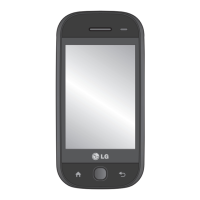- 68 -
LGE Internal Use Only Copyright © 2009 LG Electronics. Inc. All right reserved.
Only for training and service purposes
3. Technical Brief
The MSM7200A audio front end comprises the stereo wideband codec, PCM interface, and additional DSP
audio processing.
The stereo wideband codec allows the MSM7200A device to support stereo music/ringer melody applications in
addition to the 8 kHz voice band applications on the forward link.
In the audio transmit path, the device operates as 13-bit linear converter with software, selectable 8 kHz and 16
kHz sampling rate. In the audio receive path, the device operates as a software-selectable 13-bit or 16-bit linear
converter with software selectable 8 kHz, 16 kHz, 22.05 kHz, 24 kHz, 32 kHz, 44.1 kHz, or 48 kHz sampling rate.
Through software, the Rx path can be configured as either a mono or stereo output.
New to the MSM7200A device is a transmit (Tx) ADC path that now supports stereo wideband sampling.
The integrated codec contains all of the required conversion and amplification stages for the audio front end.
The codec operates as a 13-bit linear codec with the transmit (Tx) and receive (Rx) filters designed to meet ITU-T
G.712 requirements. The codec includes a programmable side tone path for summing a portion of the Tx audio
into the Rx path.
An on-chip voltage/current reference is provided to generate the precise voltages and currents required by the
codec. This circuit requires a single capacitor of 0.1 F to be connected between the CCOMP and GND pins. The
on-chip voltage reference also provides a microphone bias voltage required for electrets condenser
microphones typically used in handset applications. The MICBIAS output pin is designed to provide 1.8 V DC
while delivering as much as 1 mA of current. Audio decoder summing and headset switch
detection are included.
The codec interface includes the amplification stages for both the microphone and earphone. On the transmit
(Tx) path, the interface supports two differential microphone inputs, a differential auxiliary input, and a stereo
line input. On the receive (Rx) path the interface supports one differential earphone output, a stereo single-
ended headphone output, one differential auxiliary output, and stereo single-ended line outputs.
The codec is configured by the codec SBI registers. The codec interface is shown in Figure.
Also part of the audio front end is the PCM interface. The PCM interface allows for an external codec to be used
instead of the internal codec. This interface can be used in I2S mode which will allows for an external stereo DAC
to be used.
Finally, the audio front end includes additional DSP audio processing that does gains, filtering and other audio
processing.
The DSP audio processing is configured through the QDSP5000 command types and is not directly controlled by
the microprocessor.
3.15.2. Audio signal processing & interface
3.15.2.1 MSM7200A audio interface

